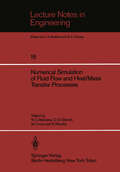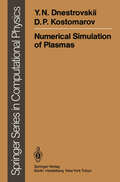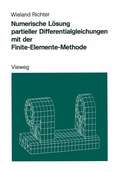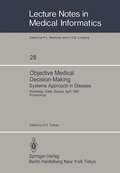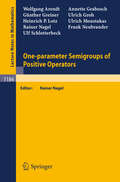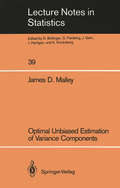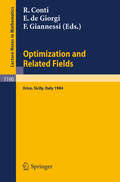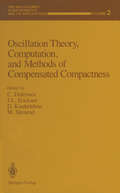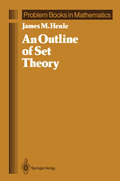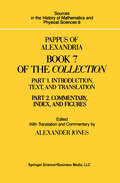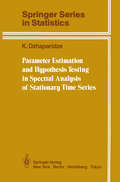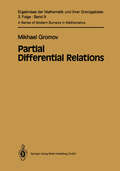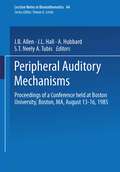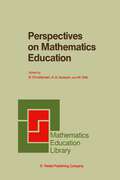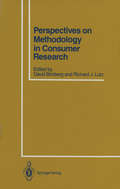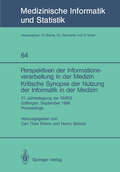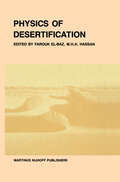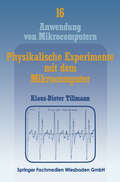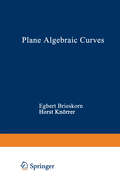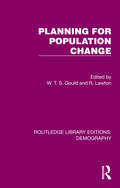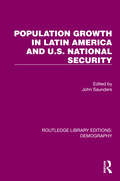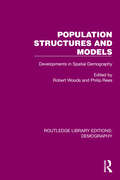- Table View
- List View
Numerical Simulation of Fluid Flow and Heat/Mass Transfer Processes (Lecture Notes in Engineering #18)
by N. C. Markatos D. G. Tatchell M. Cross N. RhodesComputational fluid flow is not an easy subject. Not only is the mathematical representation of physico-chemical hydrodynamics complex, but the accurate numerical solution of the resulting equations has challenged many numerate scientists and engineers over the past two decades. The modelling of physical phenomena and testing of new numerical schemes has been aided in the last 10 years or so by a number of basic fluid flow programs (MAC, TEACH, 2-E-FIX, GENMIX, etc). However, in 1981 a program (perhaps more precisely, a software product) called PHOENICS was released that was then (and still remains) arguably, the most powerful computational tool in the whole area of endeavour surrounding fluid dynamics. The aim of PHOENICS is to provide a framework for the modelling of complex processes involving fluid flow, heat transfer and chemical reactions. PHOENICS has now been is use for four years by a wide range of users across the world. It was thus perceived as useful to provide a forum for PHOENICS users to share their experiences in trying to address a wide range of problems. So it was that the First International PHOENICS Users Conference was conceived and planned for September 1985. The location, at the Dartford Campus of Thames Polytechnic, in the event, proved to be an ideal site, encouraging substantial interaction between the participants.
Numerical Simulation of Plasmas (Scientific Computation)
by Y.N. Dnestrovskii D.P. KostomarovThis book is devoted to mathematical modeling of tokamak plasma. Since the appearance in 1982 of the first edition (in Russian), a considerable amount of experimental and theoretical material on tokamak research has been accumu lated. The new-generation devices, viz. , TFTR, JET and JT-60 were put into operation. The first experiments on these units have confirmed the correctness of the basic physical concepts underlying their construction. Experiments on plasma heating with the help of neutral beams and high-frequency (HF) waves on previous generation devices made it possible to obtain high-P plasmas. The number of "medium-size" tokamaks in operation has increased. New experi mental results and advances in the theory have led to more complicated and perfected models of high-temperature plasma. Rapid progress in computer hardware and software has played an important role in the further development of mathematical modeling. While preparing the English edition of the book, we have revised the text considerably. Several new models which have undergone significant advance ment in recent years are described. A section devoted to models of RF (radio frequency) current drive has been added to Chap. 2. The reduced magneto hydrodynamic (MHD) equations for high-P plasma are now considered in detail in Chap. 3. Chapter 4 contains the latest results on anomalous thermal conductivity, diffusion coefficient and pinching. Two new sections are added to Chap. 5.
Numerische Lösung partieller Differentialgleichungen mit der Finite-Elemente-Methode
by Wieland RichterObjective Medical Decision-Making Systems Approach in Disease: Workshop, Crete, Greece, April 30–May 5, 1985 Proceedings (Lecture Notes in Medical Informatics #28)
by Dimitris D. TsiftsisOne-parameter Semigroups of Positive Operators (Lecture Notes in Mathematics #1184)
by Wolfgang Arendt Annette Grabosch Günther Greiner Ulrich Groh Heinrich P. Lotz Ulrich Moustakas Rainer Nagel Frank Neubrander Ulf SchlotterbeckOptimal Unbiased Estimation of Variance Components (Lecture Notes in Statistics #39)
by James D. MalleyOptimization and Related Fields: Proceedings of the G. Stampacchia International School of Mathematics, held at Erice, Sicily, September 17-30, 1984 (Lecture Notes in Mathematics #1190)
by Roberto Conti Ennio De Giorgi Franco GiannessiOscillation Theory, Computation, and Methods of Compensated Compactness (The IMA Volumes in Mathematics and its Applications #2)
by C. Dafermos J. L. Ericksen D. Kinderlehrer M. SlemrodAn Outline of Set Theory (Problem Books in Mathematics)
by James M. HenleThis book is designed for use in a one semester problem-oriented course in undergraduate set theory. The combination of level and format is somewhat unusual and deserves an explanation. Normally, problem courses are offered to graduate students or selected undergraduates. I have found, however, that the experience is equally valuable to ordinary mathematics majors. I use a recent modification of R. L. Moore's famous method developed in recent years by D. W. Cohen [1]. Briefly, in this new approach, projects are assigned to groups of students each week. With all the necessary assistance from the instructor, the groups complete their projects, carefully write a short paper for their classmates, and then, in the single weekly class meeting, lecture on their results. While the em phasis is on the student, the instructor is available at every stage to assure success in the research, to explain and critique mathematical prose, and to coach the groups in clear mathematical presentation. The subject matter of set theory is peculiarly appropriate to this style of course. For much of the book the objects of study are familiar and while the theorems are significant and often deep, it is the methods and ideas that are most important. The necessity of rea soning about numbers and sets forces students to come to grips with the nature of proof, logic, and mathematics. In their research they experience the same dilemmas and uncertainties that faced the pio neers.
Pappus of Alexandria Book 7 of the Collection: Part 1. Introduction, Text, and Translation (Sources in the History of Mathematics and Physical Sciences #8)
by Alexander JonesThe seventh book of Pappus's Collection, his commentary on the Domain (or Treasury) of Analysis, figures prominently in the history of both ancient and modern mathematics: as our chief source of information concerning several lost works of the Greek geometers Euclid and Apollonius, and as a book that inspired later mathematicians, among them Viete, Newton, and Chasles, to original discoveries in their pursuit of the lost science of antiquity. This presentation of it is concerned solely with recovering what can be learned from Pappus about Greek mathematics. The main part of it comprises a new edition of Book 7; a literal translation; and a commentary on textual, historical, and mathematical aspects of the book. It proved to be convenient to divide the commentary into two parts, the notes to the text and translation, and essays about the lost works that Pappus discusses. The first function of an edition of this kind is, not to expose new discoveries, but to present a reliable text and organize the accumulated knowledge about it for the reader's convenience. Nevertheless there are novelties here. The text is based on a fresh transcription of Vat. gr. 218, the archetype of all extant manuscripts, and in it I have adopted numerous readings, on manuscript authority or by emendation, that differ from those of the old edition of Hultsch. Moreover, many difficult parts of the work have received little or no commentary hitherto.
Parameter Estimation and Hypothesis Testing in Spectral Analysis of Stationary Time Series (Springer Series in Statistics)
by K. Dzhaparidze. . ) (under the assumption that the spectral density exists). For this reason, a vast amount of periodical and monographic literature is devoted to the nonparametric statistical problem of estimating the function tJ( T) and especially that of leA) (see, for example, the books [4,21,22,26,56,77,137,139,140,]). However, the empirical value t;; of the spectral density I obtained by applying a certain statistical procedure to the observed values of the variables Xl' . . . , X , usually depends in n a complicated manner on the cyclic frequency). . This fact often presents difficulties in applying the obtained estimate t;; of the function I to the solution of specific problems rela ted to the process X . Theref ore, in practice, the t obtained values of the estimator t;; (or an estimator of the covariance function tJ~( T» are almost always "smoothed," i. e. , are approximated by values of a certain sufficiently simple function 1 = 1
Partial Differential Relations (Ergebnisse der Mathematik und ihrer Grenzgebiete. 3. Folge / A Series of Modern Surveys in Mathematics #9)
by Misha GromovThe classical theory of partial differential equations is rooted in physics, where equations (are assumed to) describe the laws of nature. Law abiding functions, which satisfy such an equation, are very rare in the space of all admissible functions (regardless of a particular topology in a function space). Moreover, some additional (like initial or boundary) conditions often insure the uniqueness of solutions. The existence of these is usually established with some apriori estimates which locate a possible solution in a given function space. We deal in this book with a completely different class of partial differential equations (and more general relations) which arise in differential geometry rather than in physics. Our equations are, for the most part, undetermined (or, at least, behave like those) and their solutions are rather dense in spaces of functions. We solve and classify solutions of these equations by means of direct (and not so direct) geometric constructions. Our exposition is elementary and the proofs of the basic results are selfcontained. However, there is a number of examples and exercises (of variable difficulty), where the treatment of a particular equation requires a certain knowledge of pertinent facts in the surrounding field. The techniques we employ, though quite general, do not cover all geometrically interesting equations. The border of the unexplored territory is marked by a number of open questions throughout the book.
Peripheral Auditory Mechanisms: Proceedings of a conference held at Boston University, Boston, MA, August 13–16, 1985 (Lecture Notes in Biomathematics #64)
by J. B. Allen J. L. Hall A. Hubbard S. T. Neely A. TubisHow weIl can we model experimental observations of the peripheral auditory system'? What theoretical predictions can we make that might be tested'? It was with these questions in mind that we organized the 1985 Mechanics of Hearing Workshop, to bring together auditory researchers to compare models with experimental observations. Tbe workshop forum was inspired by the very successful 1983 Mechanics of Hearing Workshop in Delft [1]. Boston University was chosen as the site of our meeting because of the Boston area's role as a center for hearing research in this country. We made a special effort at this meeting to attract students from around the world, because without students this field will not progress. Financial support for the workshop was provided in part by grant BNS- 8412878 from the National Science Foundation. Modeling is a traditional strategy in science and plays an important role in the scientific method. Models are the bridge between theory and experiment. Tbey test the assumptions made in experimental designs. They are built on experimental results, and they may be used to test hypotheses and predict experimental results. Tbe latter is the scientific method at its best. Cochlear function is very complicated. For this reason, models play animportant role. One goal of modeling is to gain understanding, but the necessary mathematical tools are often formidably complex. An ex am pie of this is found in cochlear macromechanics.
Perspectives on Mathematics Education: Papers Submitted by Members of the Bacomet Group (Mathematics Education Library #2)
by M. Otte A. G. Howson B. ChristiansenBACOMET cannot be evaluated solely on the basis of its publications. It is important then that the reader, with only this volume on which to judge both the BACOMET activities and its major outcome to date, should know some thing of what preceded this book's publication. For it is the story of how a group of educators, mainly tutors of student-teachers of mathematics, com mitted themselves to a continuing period of work and self-education. The concept of BACOMET developed during a series of meetings held in 1978-79 between the three editors, Bent Christiansen, Geoffrey Howson and Michael Otte, at which we expressed our concern about the contributions from mathematics education as a discipline to teacher education, both as we observed it and as we participated in it. The short time which was at the teacher-educator's disposal, allied to the limited knowledge and experience of the students on which one had to build, raised puzzling problems concerning priorities and emphases. The recognition that these problems were shared by educators from many different countries was matched by the fact that it would be fruitless to attempt to search for an internationally (or even nationally) acceptable solution to our problems. Different contexts and traditions rule this out.
Perspectives on Methodology in Consumer Research
by Richard J. Lutz David BrinbergMethodological advances in consumer behavior are increasing rapidly. We can characterize these advances by work in two logically separate but functionally related areas: (a) the philosophical underpinnings of our methods, and (b) the analytic strategies for examining the phenomena of interest in the field. An important aspect in communicating these advances is the demonstration of their use on focal problems in consumer behavior. Current research strategies and analytic techniques in the field of consumer research reflect the dominant logical empiricist epistemology. The develop ment of new epistemologies (e.g., scientific relativism, hypothetical realism), however, is likely to modify the dominant logical empiricist approach and is also likely to influence the analytic strategies used to conduct research. For instance, with the increased awareness of scientific relativism and hypothet ical realism, greater emphasis is anticipated for idiographic rather than nomo thetic designs, for observational rather than experimental designs, for process rather than static analyses, and for more sophisticated techniques for summariz ing findings across studies. The major theme underlying this volume is that conceptual, analytic, and sub stantive diversity are essential for consumer behavior research to advance. Col lectively, the chapters we present in this volume are a diverse set of perspectives for the study of consumer behavior. This volume is organized into three parts: (1) philosophical orientations toward consumer behavior research, (2) analytic strategies for consumer behavior research, and (3) applications of these orientations and strategies to current research areas.
Perspektiven der Informationsverarbeitung in der Medizin Kritische Synopse der Nutzung der Informatik in der Medizin: 31. Jahrestagung der GMDS Göttingen, September 1986 Proceedings (Medizinische Informatik, Biometrie und Epidemiologie #64)
Eriiffnung Aktuelle Herausforderungen der medizinischen Informationsverarbeitung Selbmann. H. -K. 3 Grundsatzreferate Die Rolle der Epidemiologie fUr die Gesundheitspolitik Suj3muth. R. 9 Organisation des Gehirns und artifizielle Intelligenz Creutzfeldt. O. D. 10 Informatik im Wandel Seegmuller. G. 11 Einfiihrung in die Thematik der Tagung Kritische Synopse der Nutzung der Informatik in der Medizin. - Aus der Sicht der praktischen Erfahrung - Ehlers. C. Th. 17 Perspektiven der Datenverarbeitung in der klinischen Medizin Just. H. 23 Gesundheitsiikonomie und Planung Indikatorensysteme fiir die Krankenhausplanung Eimeren van. W. 29 Das Mikrosimulationssystem des Sonderforschungsbereiches 3: ein Analyseinstrument fiir Ver1lnderungsvorschl1lge der Gesundheitssicherung Brennecke. R. 35 Diagnosebezogene Abrechnungssysteme und ihr EinfluB auf die Struktur der Krankenhauser Kampe. D. M. 40 Budgetierung und Fallkosten-Abrechnung 44 Hildebrand. R. Klinische Diagnosendokumentation Vier Jahrzehnte Dokumentation in der Inneren Medizin. Erwartungen und Erfahrungen 51 Fritze. E. IV Die Nutzung der Basisdokumentation im Medizinischen Infor mationssystem Kiel (MEDIK) Hedderich, J" K, Sauter, K, Carstensen 57 Diagnosenstatistik nach der neuen BPflV und Ausbau zu einer Basisdokumentation Muhs, G. , R. Sawinski, P. Haas, J. R. Mohr 61 Konzeption und Implementierung eines DV -gestiitzten Diagnose erfassungs- und -Auswertungssystems Bulzebruck, H. 65 Auswirkung von Schweregrad der Krankheit und Multimor biditat auf Aufenthaltsdauer und Komplikationsrate Thurmayr, R. 70 Der Hornheider Weg vom Dokumentations- zum Informations system. - Ein struktur- und bedarfsorientierter Weg - Lippold, A. , H. Drepper 74 Offentliches Gesundheitswesen und Epidemiologie Organisatorische und datenschutzrechtliche Gesichts punkte bei der Validierung von Mortalitatsdaten Giersiepen, K. , E.
Physics of desertification
by M. H. A.Hassan FaroukEl-BazDeserts are parts of the Earth that receive little or no rain; 25 cm or less per year. The physical processes that act upon these parched lands are vastly different from those that shape the more humid parts of the terrestrial landmasses. In the desert, wind is a major agent of erosion and transportation. As the results of recent space missions have indicated, this is also true in the case of the planet Mars. Thus, our understanding of desert processes sheds light on fundamental planetary processes that may apply on any planetary body that is enveloped by a windy atmosphere. An understanding of the physical layout of arid lands, and the nature of processes that initiate changes therein is also fundamental to thoughtful utilization of these lands for the benefit of mankind. It is with this in mind that we prepared this book for publication. We believe that the collection of articles in this book will be useful to scientists who are interested in desert landforms and processes, and to planners of economic develop ment of arid lands. The book also serves as a guide for students as to the state of our knowledge in this field as well as to the topics that require additional research.
Physikalische Experimente mit dem Mikrocomputer: „On-Line“-Messungen mit dem Apple II im Apple-Pascal-System (Anwendung von Mikrocomputern #16)
by Klaus-Dieter TillmannDer Einsatz des Computers in physikalischen Experimenten erschließt eine Reihe von Versuchen, die sich bisher der direkten Messung und der graphischen Darstellung entzogen. Hierzu gehören insbesondere Versuche, die - nicht periodisch sind, - umfangreiche Auswertungen vieler ~lIeßdaten erfordern, - zu schnell für den Plotter und zu langsam für das Oszilloskop sind und - viele Messungen schnell hintereinander verlangen. In diesem Buch werden nur "On-Line"-Messungen und Auswertungen durchgeführt. Hier erlangt der Computer eine gewichtigere Bedeutung als bei der Simulation physikalischer Probleme. Typische Beispiele sind der freie Fall, optische und akustische Einzelmessungen, Schwingungsversuche und Fahrbahnversuche. Experimente, bei denen Signale bereits in elektrischer Form vorliegen, bieten sich direkt an. Bei Versuchen zur Mechanik muß erst ein elektrisches Signal erzeugt werden. Sofern möglich oder erforderlich werden alle Versuche beispielhaft durchgerechnet. Dieses Buch eignet sich daher als Anleitung, Versuche selb ständig zu konzipieren, durchzuführen und auszuwerten. Zu Beginn wird die Steuerung des Programms durch Menükarten beschrieben, um dann sofort zu den Experimenten aus verschiedenen physikalischen Gebieten zu kommen. Die Versuche werden zuerst analysiert und die Grundlagen gelegt. Hierbei werden häufig Differentialgleichungen benutzt. Hieran schließt sich die Messung mit Angabe aller benötigten Parameter und der graphischen Auswer tung an. Die analoqen und digitalen ~~essungen unterscheiden sich nicht nur durch die Hardware, sondern auch in der konzeptionellen Überlegung. Daher wer den diese beiden ~"eßmethoden auch äußerl ich getrennt.
Planning for Population Change (Routledge Library Editions: Demography #6)
by W. T. S. GouldOriginally published in 1986, this book explores many important aspects of the relationship between population change and planning, exploring the impact of population change on service provision and its impact on the policy-making process. In all countries, whether their population is expanding. ageing or stagnating, population mobility is an important cause of economic and social development. This book argues that there is a need for greater sensitivity about population change in policy-making and service provision and suggests ways of achieving this.
Planning for Population Change (Routledge Library Editions: Demography #6)
Originally published in 1986, this book explores many important aspects of the relationship between population change and planning, exploring the impact of population change on service provision and its impact on the policy-making process. In all countries, whether their population is expanding. ageing or stagnating, population mobility is an important cause of economic and social development. This book argues that there is a need for greater sensitivity about population change in policy-making and service provision and suggests ways of achieving this.
Population Growth In Latin America And U.S. National Security (Routledge Library Editions: Demography #11)
by John SaundersOriginally published in 1986, this volume deals with both population growth in Latin America and the possible consequences of this growth for the security of the USA. The text analyses the demographic dimensions of the phenomenon and then considers the consequences for US security. It was the first time that the interrelations between national security and population growth were systematically analyzed. The book predicts the raid population growth would have serious economic, social and strategic implications for the USA and rightly predicts the adoption of draconian measures to stem the flow of illegal migrants. Although some aspects of the political landscape have changed since original publication the issue of migration to the USA from Latin America has lost none of its relevance.
Population Growth In Latin America And U.S. National Security (Routledge Library Editions: Demography #11)
by John SaundersOriginally published in 1986, this volume deals with both population growth in Latin America and the possible consequences of this growth for the security of the USA. The text analyses the demographic dimensions of the phenomenon and then considers the consequences for US security. It was the first time that the interrelations between national security and population growth were systematically analyzed. The book predicts the raid population growth would have serious economic, social and strategic implications for the USA and rightly predicts the adoption of draconian measures to stem the flow of illegal migrants. Although some aspects of the political landscape have changed since original publication the issue of migration to the USA from Latin America has lost none of its relevance.
Population Structures and Models: Developments in Spatial Demography (Routledge Library Editions: Demography #14)
by Robert Woods Philip ReesOriginally published in 1986, this volume brings together geographical modelling of population change and demographic analysis of population structures and pattern. These 2 strands are interwoven in 3 key review chapters that summarize the study of spatial and temporal patterns of population, the modelling of spatial populations and the estimation of population processes. Findings reported include: An account of demographic transition; an exposé of the myth of ‘no fertility rises’ in the developing world in the 20th Century; a theory of population accounting; predicting migration flows for a system of regions; microsimulation methods to model population change; and demographic and economic processes integrated in an urban region model.
Population Structures and Models: Developments in Spatial Demography (Routledge Library Editions: Demography #14)
by Robert Woods Philip ReesOriginally published in 1986, this volume brings together geographical modelling of population change and demographic analysis of population structures and pattern. These 2 strands are interwoven in 3 key review chapters that summarize the study of spatial and temporal patterns of population, the modelling of spatial populations and the estimation of population processes. Findings reported include: An account of demographic transition; an exposé of the myth of ‘no fertility rises’ in the developing world in the 20th Century; a theory of population accounting; predicting migration flows for a system of regions; microsimulation methods to model population change; and demographic and economic processes integrated in an urban region model.
